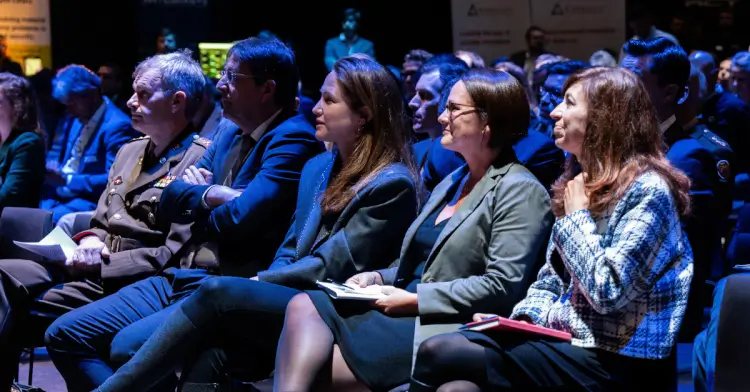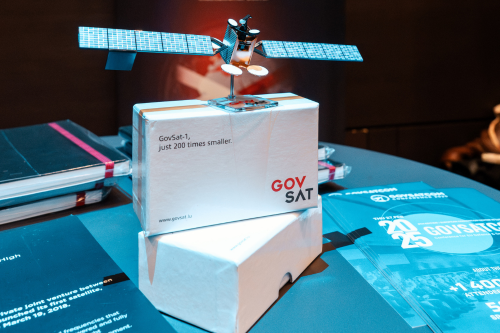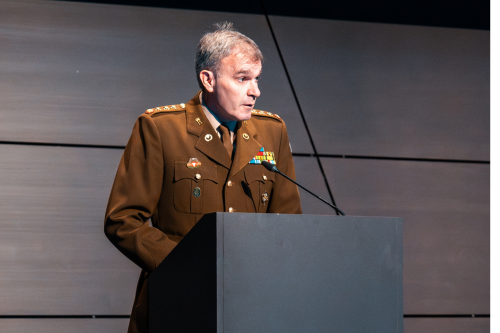


Over 200 national and European defence stakeholders met at the Luxembourg Defence Technology and Innovation Day organised by Luxinnovation and the Luxembourg Directorate of Defence.
 Abigail Okorodus
Abigail Okorodus
Luxembourg is taking active steps to strengthen its capabilities in priority defence domains such as land, air, cyber and space. The innovation taking place across board aligns with policy directives for the coming decade, which includes among others, ambitions to modernise and enhance research and innovation activities.
We need to continue to see initiatives that strengthen our defence technology and our industrial base.
Yuriko Backes, Minister of Defence
This first-ever Defence Technology and Innovation Day convened leaders from government, the EU, research institutions and industry to explore strategies and initiatives for European security and defence. The primary objective was to foster new partnerships to enhance resilience across the sector.
“We need to continue to see initiatives that strengthen our defence technology and our industrial base,” pointed out Minister of Defence, Yuriko Backes, who highlighted the government’s renewed commitment to boost the defence budget to 2% of GDP by 2030.
In light of this, it has become increasingly essential for national actors to integrate into EU and NATO defence value chains. Exhibitors seized the opportunity to showcase their latest innovations in this sector, which is gaining momentum and well-placed to make vital contributions to collective security across the Euro-Atlantic region.
"Luxembourg defence projects are very much NATO-driven," clarified Lieutenant Colonel Guillaume Hansen, Head of Department Capacity Development (Land) at the Luxembourg Armed Forces. In the land domain, Luxembourg, in its binational collaboration with Belgium, has set new goals for 2032. These include creating a battalion of around 350 soldiers and acquiring new armoured vehicles with a 30-ton weapon capacity, a significant increase from the current 10-ton light vehicles.
To achieve these targets, several actions are required in terms of infrastructure, mobility, training, sustainment and other strategic areas, requiring the input of research and innovation community.
Alain Dirkes, Attaché Space Defence Programmes at the Directorate of Defence, highlighted efforts to enhance space capabilities based on the 2022 strategic framework. “The main objective is that Luxembourg defence will consolidate its role as a reliable reference partner in the field of space by 2030,” he mentioned. National space assets, such as the Earth observation system LUXEOSy is set to launch in the second quarter of 2025. “With this new space asset, we will foster institutional and bilateral cooperations,” he stated.
National actors are now enabled to look out for new opportunities, that were not considered a priority only a few years ago.
Colonel Guy Hoffmann, Directorate of Defence
 Other assets like the GovSat-1 satellite has also been providing secure satellite communications to governmental and institutional users since 2018. In collaboration with the Luxembourg Armed Forces, two new large antennas were recently built at the military centre in Diekirch to support its satellite operations.
Other assets like the GovSat-1 satellite has also been providing secure satellite communications to governmental and institutional users since 2018. In collaboration with the Luxembourg Armed Forces, two new large antennas were recently built at the military centre in Diekirch to support its satellite operations.
Collectively, these solutions bolster both NATO and European defence. “We basically use them to support the Luxembourg armed forces for their different trainings, exercises and missions abroad, like, for instance, the new NATO mission in Romania, the EU military assistance mission in Mozambique, or the NATO enhanced forward presence mission in Lithuania,” added Mr Dirkes.
In the field of air defence, the Grand Duchy has also made investments in significant assets such as the A400M military transport aircraft and H-145M helicopters used by the police force. It is increasingly taking on more active roles in this domain. The country has been part of the Alliance Future Surveillance and Control consortium set up in 2023 with six other NATO nations: Belgium, Germany, the Netherlands, Norway, Romania and the United States. LtCol George Campill, Head of Air Office at the Directorate of Defence disclosed the network’s plans to replace its current fleet with a Boeing E-7 Wedgetail aircraft by 2032.
We want to have one of NATO’s and the EU’s most secure cyber defences, and this is on purpose.
Ben Fetler, Directorate of Defence
The country’s cyber capabilities are being reinforced to meet its objectives set in the national strategy. “We want to have one of NATO’s and the EU’s most secure cyber defences, and this is on purpose, because the weakest link in cyber can be a potential danger for the whole allied forces,” stressed Ben Fetler, Head of Cyber at the Directorate of Defence.
The Luxembourg Cyber Range platform was inaugurated in 2021 for simulating cyber conflict scenarios, training professionals, and carrying out security testing and benchmarking. Others like the Luxembourg Cyber Defence Cloud, a 10-year project, will offer more storage and computing power in a secure environment to both national, EU and NATO players. A request for proposals will be published early next year. Several other capabilities are being developed in this domain.
 With a plethora of national and EU initiatives available to integrate into NATO and EU Defence networks, “national actors are now enabled to look out for new opportunities, that were not considered a priority only a few years ago,” explained Colonel Guy Hoffmann, National Armaments Director at the Directorate of Defence.
With a plethora of national and EU initiatives available to integrate into NATO and EU Defence networks, “national actors are now enabled to look out for new opportunities, that were not considered a priority only a few years ago,” explained Colonel Guy Hoffmann, National Armaments Director at the Directorate of Defence.
Instruments like the European Defence Fund (EDF), with a budget of €7.953 billion for 2021-2027, support collaborative defence research and development. The European Development Agency also backs research and technology (R&T) actions in defence.
Despite the ecosystem’s relatively modest size of about 100 companies, it has achieved impressive results through active participation in ad hoc R&T projects. Luxembourg is part of 17 ongoing projects worth €74.3 million.
It is our role to help the Luxembourg industry face the challenges of tomorrow for innovation and R&D.
Alexander Link, Luxinnovation
Industry and research actors looking to apply cutting-edge solutions in the security and defence sector or identify collaboration opportunities at various European levels can count on the support of Luxinnovation.
“It is our role to help the Luxembourg industry face the challenges of tomorrow for innovation and R&D, and this includes helping our industry and research players, through close collaboration with national and international partners, in meeting the needs of European security and defence,” underscored Alexander Link, Defence Technology and Innovation Coordinator at Luxinnovation.
Recently, defence working groups with industry stakeholders were set up at the Chamber of Commerce to create synergies. Likewise, NATO’s Industrial Advisory Group, which includes Luxembourg, recently set up SPACENET, a platform facilitating industry’s input to solve pressing needs in the defence sector. It currently includes about 300 companies from allied member states.
Philippe Glaesener, Senior Vice President at SES Space & Defence emphasised the need “for the industry to know what is coming, in the midterm and long term, in order to prepare, commit, and also spend all the resources that are needed for Luxembourg industry to play an important role.”